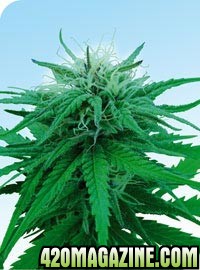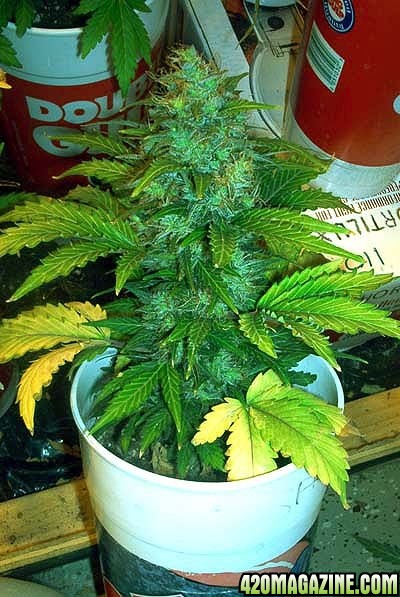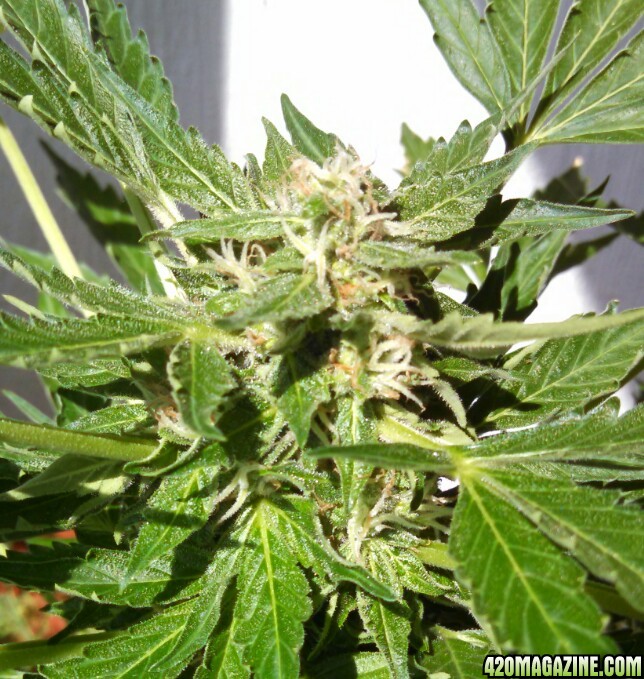Smokin Moose
Fallen Cannabis Warrior & Ex Moderator
This wild hemp strain, once discarded as useless, is making a comeback among both serious breeders and casual croppers.
Deep in the North American woods lurks a recent addition to the marijuana gene pool: Ruderalis hybrids! The forests and fields are coming alive with resinated plants, blasting their way to maturity under the intense light of the summer sun, long before the buzzing of choppers or moldy autumn weather.
Until recently, Ruderalis had been almost unanimously given a bad name by cultivators and breeders alike. Early Dutch seed pioneers like Super Sativa Seed Club voiced their concerns about Ruderalis early in the homegrown revolution. This was all with understandable reason, as pure Ruderalis varieties are almost completely devoid of THC and come with a host of other problems for the grower or breeder.
Breeding programs between Ruderalis and drug type strains can and have produced plants of notable quality. The aim of this article is to shine some light on this recent advance in marijuana breeding and pave the way to what could be the future of outdoor marijuana cultivation for many areas of the world.
What is Ruderalis?
Cannabis Ruderalis is a subspecies of Cannabis Sativa. The term was originally used in the former Soviet Union to describe the varieties of hemp that had escaped cultivation and adapted to the surrounding region.
Similar Ruderalis populations can be found in most of the areas where hemp cultivation was once prevalent. The most notable region in North America is the midwest, though populations occur sporadically throughout the United States and Canada. Without the human hand aiding in selection, these plants have lost many of the traits they were originally selected for, and have acclimatized to their locale.
Though they contain little THC, these plants hold large potential for use in breeding, both in hemp and marijuana applications. Early flowering and resistance to locally significant insect and disease pressures are but a few of the important traits present in these feral populations.
Thankfully, despite years of US government sponsored eradication programs, these wild plants still remain in bountiful abundance.
Early efforts
The first documented experiments in crossing drug strain varieties with their Ruderalis cousins were performed by Ernest Small of Agriculture Canada in Ontario during the 1970's, for the aiding in the purposes of taxonomic classification. Crosses between these strains usually produced offspring of intermediate THC levels, with a few that leaned more towards the high THC end of the spectrum. It was concluded during this research that hybrids between drug and non-drug (both ruderal and hemp cultivars were tested) generally produced progeny of intermediate potency.1
Perhaps the most known efforts to incorporate Ruderalis traits into drug hybrids are those of Nevil, proprietor of the original Seed Bank, and the person largely responsible for the original dispersion of many of today's drug varieties.
During the 1980's, Nevil experimented with crossing Ruderalis strains to plants such as Mexican, Skunk#1 and several Indicas, in hopes of combining the early flowering of the Ruderalis with the potency and flavor of the others.
Although some of Neville's crosses matured much earlier than previous marijuana strains, they tended to be low in potency, unstable in terms of maturity, and often sported buds that were leafy with shrunken calyxes.
BC's Mighty Mite
About this time, on British Columbia's Gulf islands, an outdoor grower was noticing that his October finishing strain always threw out a few plants that finished much earlier — by late July or early August. After several years of selections for this early flowering trait, the Mighty Mite strain was born.2 Mighty Mite effectively incorporated the auto-flowering trait, while retaining the habit and potency of its drug cultivar heritage.
For those in the know, Mighty Mite quickly became a popular outdoor strain for filling the traditional late summer drought in BC's pot market before the market was flooded with regular seasonal outdoor bud. Slowly, over the years, these genetics have spread further amongst underground pot growers and been used most successfully in hybridizations with more potent strains.
Aside from getting crops in before cops and other thieves can plunder them, these early plants have allowed growers to produce plants with much more commercial appeal than traditional Northern latitude outdoor marijuana.
Warm, dry summer weather with high light values allow buds to finish bright green and rock hard, making for better bag appeal. It is impossible to tell whether the many auto-flowering strains floating around all originated in the Mighty Mite family or are a result of many similar incidents, but it is certainly the most proven of all the auto-flowering strains. The fact that Mighty Mite is an inbred line and relatively true breeding for its auto-flowering trait would make it seem likely to have been a large contributor.
DJ Short has recently speculated that Ruderalis introductions into the drug cannabis gene pool likely came from repeated selections for early flowering traits from Indica based lines rather than actually being imported from Russia or surrounding countries (CC#39, Breeding Tips). Both of these scenarios are quite possible. General consensus is that all drug, hemp and feral strains of cannabis originated from the same source gene pool, therefore, Indica varieties would also have these auto-flower genes present somewhere in their genetic makeup.
Early flowering explored
The marijuana strains most of us have been familiar with begin flowering once the night period reaches the individual plant's critical night length. This critical length varies depending on where the strain originated. Generally, there is a critical period of darkness required to begin flowering, and a second slightly longer critical dark requirement for it to ripen completely.
Many Indica varieties begin to flower when the day length drops to about 13 1/2-14 hours, while Sativas will often not begin to flower until less than a 12 hour day length is achieved.
In comparison, many of today's Ruderalis/drug strain hybrids flower automatically when they reach a given maturity, regardless of photoperiod. Even under lights on 18 hours a day, they completely mature from seed to bud in less than 90 days.
I've seen test plants from Mighty Mite hybrid lines that were started outdoors in early March, and had completely finished by late July. This could indicate that crossing auto-flowering plants to those that are photoperiod determinant lengthens a genetically predetermined period required before non-photoperiod dependent floral onset.
A second scenario is that within the ruderal strains that have been introduced to the drug gene pool there also exists genetic information of photoperiod adaptation to north latitudes.
Many of these Ruderalis/drug hybrids are also known for being very sensitive to other environmental factors. Things such as cloning, letting plants go too dry or getting pot bound can easily send them into heavy flowering.
The big unknown that still remains in these new lines of marijuana is what is actually causing the flowering on a biological level? Is there an internal clock, a genetically predetermined number of cell divisions that must take place before the plant begins to put up buds?
Another possibility is that once night-induced flowering hormone levels accumulate to certain levels within the plant it will begin to flower.
If the flowering is not dependent on having a dark period, these new cultivars could prove useful in backyard city growing situations, where streetlights and other forms of light pollution often prevent proper maturation of photoperiod dependent strains.
Problems and pitfalls
As these genetics further penetrate the drug cannabis gene pool they have potential to cause both harm and good.
Imagine getting mothers up and going for your next big crop and finding that at 60 days they all begin to go into full flower. A costly inconvenience at the least!
However, the potential for great advances is also there for the taking. How about auto-flowering Haze strains that ripen in the middle of summer, in areas where previously even the earliest Indicas would not ripen in time? Commercial growers could pull two crops per summer without ever having to worry about shading!
Breeding climate
One of the largest problems associated with breeding outdoor varieties for northern latitude areas like Canada or Holland is that the climate puts no pressure on plants to produce high psychoactivity. In fact it selects for the opposite.
So long as the breeder is selecting for high potency on a multi-parent level, potency can be upheld. However, if this same breeding program were undertaken in an environment that naturally selects for high THC plants (like highland Colombia or Thailand) the resulting average desirable cannabinoid levels would be much higher.
There is likely a threshold effect on the potential of any given strain as related to the environment it is being selected in. By incorporating auto-flower genes into the north latitude outdoor marijuana gene pool, plants would be finishing under more direct sunlight and warmer weather. This environment is much more conducive to high THC levels, thereby raising the threshold level for the particular strain.
Ruderalis and hemp
It is very likely that Ruderalis varieties have already made for an important advance in hemp cultivars. The variety FIN314 was developed from genetic material originating in Russia and seems to have the same auto-flowering trait noted in Mighty Mite and other hybrids.
FIN314 seeds that accidentally germinated in a Quebec farmer's field in early April were found in full flower by early June.3 Along with adding the possibility of twin crops in a season, this allows the oilseed variety to finish short enough to be easily harvested by current machinery, which clogs when fed the standard taller hemp varieties.
The genetic history of the parents of FIN 314 is unknown, other than that they were acquired from a germplasm collection from Russia. However, it is believed that at least one of the parents was a Ruderalis accession.4 If the widespread adoption of FIN314 by hemp farmers is any indication of the future of Ruderalis/drug hybrids with pot growers, there will be a mass dispersal in the coming years.
Buyer beware
There are still many commercially offered Ruderalis hybrid strains that are very low quality and should barely be classed as drug varieties. At the same time, the finest Canadian outdoor pot to have crossed my path so far was from Mighty Mite derived lines that were harvested in July and August.
The future seems clear for Ruderalis/marijuana hybrids. As many governments ease up on antiquated cannabis laws, more and more people will take up growing. A couple of auto-flowers on the back deck will likely fit the lifestyle of many more folks than would an indoor grow room.
Demand for stabilized, auto-flowering hybrids of high drug value, in combination with saner drug laws, will pressure marijuana breeders to move forward on bringing these to fruition.
Until then, the ability to have marijuana crops maturing at any time of the growing season should wreak havoc on CAMP style police tactics that have been accustomed to only searching for plants one or two months of the year. This, if for no other reason, seems ample enough to plant some auto-flowerers today!
References
1 Small, Ernest. 1979. The Species Problem in Cannabis Science & Semantics. Volume 1: Science. Corpus Information Services Limited. In cooperation with Agriculture Canada and the Canadian Government Publishing Center. pp.121-127
2 Poole, MIchael. Romancing Mary Jane: A Year in the Life of a Failed Marijuana Grower. Greystone Books.
3 Przytyk, Sasha. Undated article. FIN 314 in Canada, Gen-X research Inc. Regina, Sask.
4 Callaway, JC, and TT Laakonen. Undated article. Cultivation of Oilseed Varieties in Finland. Department of Pharmaceutical Chemistry, University of Kuopio, Finland.
by DMT
Deep in the North American woods lurks a recent addition to the marijuana gene pool: Ruderalis hybrids! The forests and fields are coming alive with resinated plants, blasting their way to maturity under the intense light of the summer sun, long before the buzzing of choppers or moldy autumn weather.
Until recently, Ruderalis had been almost unanimously given a bad name by cultivators and breeders alike. Early Dutch seed pioneers like Super Sativa Seed Club voiced their concerns about Ruderalis early in the homegrown revolution. This was all with understandable reason, as pure Ruderalis varieties are almost completely devoid of THC and come with a host of other problems for the grower or breeder.
Breeding programs between Ruderalis and drug type strains can and have produced plants of notable quality. The aim of this article is to shine some light on this recent advance in marijuana breeding and pave the way to what could be the future of outdoor marijuana cultivation for many areas of the world.
What is Ruderalis?
Cannabis Ruderalis is a subspecies of Cannabis Sativa. The term was originally used in the former Soviet Union to describe the varieties of hemp that had escaped cultivation and adapted to the surrounding region.
Similar Ruderalis populations can be found in most of the areas where hemp cultivation was once prevalent. The most notable region in North America is the midwest, though populations occur sporadically throughout the United States and Canada. Without the human hand aiding in selection, these plants have lost many of the traits they were originally selected for, and have acclimatized to their locale.
Though they contain little THC, these plants hold large potential for use in breeding, both in hemp and marijuana applications. Early flowering and resistance to locally significant insect and disease pressures are but a few of the important traits present in these feral populations.
Thankfully, despite years of US government sponsored eradication programs, these wild plants still remain in bountiful abundance.
Early efforts
The first documented experiments in crossing drug strain varieties with their Ruderalis cousins were performed by Ernest Small of Agriculture Canada in Ontario during the 1970's, for the aiding in the purposes of taxonomic classification. Crosses between these strains usually produced offspring of intermediate THC levels, with a few that leaned more towards the high THC end of the spectrum. It was concluded during this research that hybrids between drug and non-drug (both ruderal and hemp cultivars were tested) generally produced progeny of intermediate potency.1
Perhaps the most known efforts to incorporate Ruderalis traits into drug hybrids are those of Nevil, proprietor of the original Seed Bank, and the person largely responsible for the original dispersion of many of today's drug varieties.
During the 1980's, Nevil experimented with crossing Ruderalis strains to plants such as Mexican, Skunk#1 and several Indicas, in hopes of combining the early flowering of the Ruderalis with the potency and flavor of the others.
Although some of Neville's crosses matured much earlier than previous marijuana strains, they tended to be low in potency, unstable in terms of maturity, and often sported buds that were leafy with shrunken calyxes.
BC's Mighty Mite
About this time, on British Columbia's Gulf islands, an outdoor grower was noticing that his October finishing strain always threw out a few plants that finished much earlier — by late July or early August. After several years of selections for this early flowering trait, the Mighty Mite strain was born.2 Mighty Mite effectively incorporated the auto-flowering trait, while retaining the habit and potency of its drug cultivar heritage.
For those in the know, Mighty Mite quickly became a popular outdoor strain for filling the traditional late summer drought in BC's pot market before the market was flooded with regular seasonal outdoor bud. Slowly, over the years, these genetics have spread further amongst underground pot growers and been used most successfully in hybridizations with more potent strains.
Aside from getting crops in before cops and other thieves can plunder them, these early plants have allowed growers to produce plants with much more commercial appeal than traditional Northern latitude outdoor marijuana.
Warm, dry summer weather with high light values allow buds to finish bright green and rock hard, making for better bag appeal. It is impossible to tell whether the many auto-flowering strains floating around all originated in the Mighty Mite family or are a result of many similar incidents, but it is certainly the most proven of all the auto-flowering strains. The fact that Mighty Mite is an inbred line and relatively true breeding for its auto-flowering trait would make it seem likely to have been a large contributor.
DJ Short has recently speculated that Ruderalis introductions into the drug cannabis gene pool likely came from repeated selections for early flowering traits from Indica based lines rather than actually being imported from Russia or surrounding countries (CC#39, Breeding Tips). Both of these scenarios are quite possible. General consensus is that all drug, hemp and feral strains of cannabis originated from the same source gene pool, therefore, Indica varieties would also have these auto-flower genes present somewhere in their genetic makeup.
Early flowering explored
The marijuana strains most of us have been familiar with begin flowering once the night period reaches the individual plant's critical night length. This critical length varies depending on where the strain originated. Generally, there is a critical period of darkness required to begin flowering, and a second slightly longer critical dark requirement for it to ripen completely.
Many Indica varieties begin to flower when the day length drops to about 13 1/2-14 hours, while Sativas will often not begin to flower until less than a 12 hour day length is achieved.
In comparison, many of today's Ruderalis/drug strain hybrids flower automatically when they reach a given maturity, regardless of photoperiod. Even under lights on 18 hours a day, they completely mature from seed to bud in less than 90 days.
I've seen test plants from Mighty Mite hybrid lines that were started outdoors in early March, and had completely finished by late July. This could indicate that crossing auto-flowering plants to those that are photoperiod determinant lengthens a genetically predetermined period required before non-photoperiod dependent floral onset.
A second scenario is that within the ruderal strains that have been introduced to the drug gene pool there also exists genetic information of photoperiod adaptation to north latitudes.
Many of these Ruderalis/drug hybrids are also known for being very sensitive to other environmental factors. Things such as cloning, letting plants go too dry or getting pot bound can easily send them into heavy flowering.
The big unknown that still remains in these new lines of marijuana is what is actually causing the flowering on a biological level? Is there an internal clock, a genetically predetermined number of cell divisions that must take place before the plant begins to put up buds?
Another possibility is that once night-induced flowering hormone levels accumulate to certain levels within the plant it will begin to flower.
If the flowering is not dependent on having a dark period, these new cultivars could prove useful in backyard city growing situations, where streetlights and other forms of light pollution often prevent proper maturation of photoperiod dependent strains.
Problems and pitfalls
As these genetics further penetrate the drug cannabis gene pool they have potential to cause both harm and good.
Imagine getting mothers up and going for your next big crop and finding that at 60 days they all begin to go into full flower. A costly inconvenience at the least!
However, the potential for great advances is also there for the taking. How about auto-flowering Haze strains that ripen in the middle of summer, in areas where previously even the earliest Indicas would not ripen in time? Commercial growers could pull two crops per summer without ever having to worry about shading!
Breeding climate
One of the largest problems associated with breeding outdoor varieties for northern latitude areas like Canada or Holland is that the climate puts no pressure on plants to produce high psychoactivity. In fact it selects for the opposite.
So long as the breeder is selecting for high potency on a multi-parent level, potency can be upheld. However, if this same breeding program were undertaken in an environment that naturally selects for high THC plants (like highland Colombia or Thailand) the resulting average desirable cannabinoid levels would be much higher.
There is likely a threshold effect on the potential of any given strain as related to the environment it is being selected in. By incorporating auto-flower genes into the north latitude outdoor marijuana gene pool, plants would be finishing under more direct sunlight and warmer weather. This environment is much more conducive to high THC levels, thereby raising the threshold level for the particular strain.
Ruderalis and hemp
It is very likely that Ruderalis varieties have already made for an important advance in hemp cultivars. The variety FIN314 was developed from genetic material originating in Russia and seems to have the same auto-flowering trait noted in Mighty Mite and other hybrids.
FIN314 seeds that accidentally germinated in a Quebec farmer's field in early April were found in full flower by early June.3 Along with adding the possibility of twin crops in a season, this allows the oilseed variety to finish short enough to be easily harvested by current machinery, which clogs when fed the standard taller hemp varieties.
The genetic history of the parents of FIN 314 is unknown, other than that they were acquired from a germplasm collection from Russia. However, it is believed that at least one of the parents was a Ruderalis accession.4 If the widespread adoption of FIN314 by hemp farmers is any indication of the future of Ruderalis/drug hybrids with pot growers, there will be a mass dispersal in the coming years.
Buyer beware
There are still many commercially offered Ruderalis hybrid strains that are very low quality and should barely be classed as drug varieties. At the same time, the finest Canadian outdoor pot to have crossed my path so far was from Mighty Mite derived lines that were harvested in July and August.
The future seems clear for Ruderalis/marijuana hybrids. As many governments ease up on antiquated cannabis laws, more and more people will take up growing. A couple of auto-flowers on the back deck will likely fit the lifestyle of many more folks than would an indoor grow room.
Demand for stabilized, auto-flowering hybrids of high drug value, in combination with saner drug laws, will pressure marijuana breeders to move forward on bringing these to fruition.
Until then, the ability to have marijuana crops maturing at any time of the growing season should wreak havoc on CAMP style police tactics that have been accustomed to only searching for plants one or two months of the year. This, if for no other reason, seems ample enough to plant some auto-flowerers today!
References
1 Small, Ernest. 1979. The Species Problem in Cannabis Science & Semantics. Volume 1: Science. Corpus Information Services Limited. In cooperation with Agriculture Canada and the Canadian Government Publishing Center. pp.121-127
2 Poole, MIchael. Romancing Mary Jane: A Year in the Life of a Failed Marijuana Grower. Greystone Books.
3 Przytyk, Sasha. Undated article. FIN 314 in Canada, Gen-X research Inc. Regina, Sask.
4 Callaway, JC, and TT Laakonen. Undated article. Cultivation of Oilseed Varieties in Finland. Department of Pharmaceutical Chemistry, University of Kuopio, Finland.
by DMT







 I may have to test those out. If there is genetic consistancy, these would be awesome to grow. Otherwise, cloning would be a must.
I may have to test those out. If there is genetic consistancy, these would be awesome to grow. Otherwise, cloning would be a must. I have been looking for a good source on this 420 is always the way to go haha.
I have been looking for a good source on this 420 is always the way to go haha.
